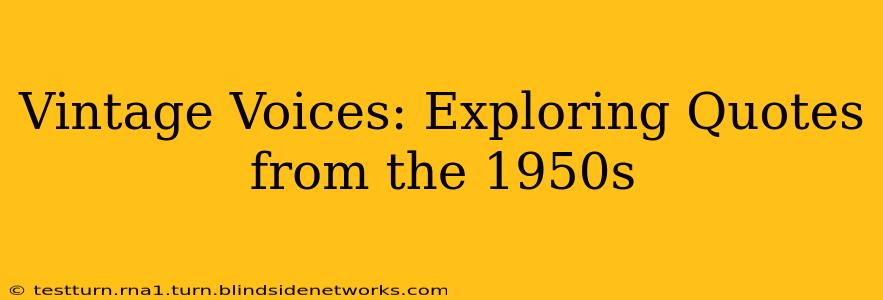The 1950s. A decade conjuring images of poodle skirts, sock hops, and gleaming chrome. But beyond the iconic imagery lies a rich tapestry of social, political, and cultural shifts reflected in the words of the time. This isn't just about remembering catchy phrases; it's about understanding the anxieties, aspirations, and evolving consciousness of a generation on the cusp of profound change. Let's delve into some memorable quotes from the 1950s, exploring their context and enduring resonance.
What defined the cultural landscape of the 1950s?
The 1950s were a period of significant post-war economic boom in the United States, leading to a rise in consumerism and suburbanization. This prosperity, however, masked underlying social tensions. The Cold War cast a long shadow, fueling anxieties about communism and nuclear war. The Civil Rights Movement began to gain momentum, challenging deeply ingrained racial segregation and inequality. These competing forces – prosperity and fear, progress and prejudice – shaped the prevailing attitudes and found expression in the words spoken and written during this decade.
What are some famous quotes from the 1950s?
Many iconic quotes from the 1950s encapsulate the spirit of the era. While attributing specific quotes to precise individuals can sometimes be challenging due to the nature of oral traditions and evolving popular culture, certain phrases became widely associated with the decade's zeitgeist. For instance, the ubiquitous phrase "Keep Calm and Carry On," though originating earlier, experienced a revival in popularity during this period, reflecting a stoic resilience in the face of Cold War tensions. Similarly, "It's the American Way" became a rallying cry, representing both the nation's economic success and its often-unexplored internal contradictions.
What were some of the most influential speeches of the 1950s?
The 1950s witnessed several influential speeches that shaped public discourse. President Dwight D. Eisenhower's farewell address, warning against the growing military-industrial complex, remains a powerful example of prescient political commentary. Martin Luther King Jr.'s early sermons, though not yet reaching national prominence, laid the groundwork for his later, iconic addresses, foreshadowing the power of nonviolent resistance. These speeches, though varying widely in their themes, all contributed to the ongoing national conversation about identity, freedom, and the future.
How did the 1950s influence modern language?
The 1950s' impact on modern language is subtle yet pervasive. Certain slang terms and expressions, though often short-lived in their original popularity, continue to resonate in modern parlance. Understanding the context in which these terms arose provides valuable insight into the social dynamics of the era. Additionally, the rise of television and mass media during the 1950s played a pivotal role in disseminating certain phrases and catchphrases, solidifying their place in collective memory.
What were the main social issues of the 1950s?
The 1950s were marked by significant social issues, including racial segregation, gender inequality, and the growing anxieties surrounding the Cold War. These issues are reflected in the literature, music, and political discourse of the time. While the decade saw some advancements in areas like consumerism and technological development, the underlying social tensions foreshadowed the turbulent changes of the following decades.
How did the 1950s influence popular culture?
The influence of the 1950s on popular culture is undeniable. From the fashion and music to the cinematic depictions of the era, the 1950s continue to inspire contemporary artists and creators. The nostalgia associated with this era often overlooks the complexities and contradictions of the time, yet its enduring appeal speaks to the human longing for simpler times and idealized visions of the past.
In conclusion, exploring the vintage voices of the 1950s offers more than just a nostalgic trip down memory lane. It's a chance to understand the nuances of a pivotal decade, one that laid the groundwork for many of the social, political, and cultural challenges and triumphs we face today. By examining the quotes, speeches, and cultural artifacts of the era, we gain a deeper appreciation for the complexities of the past and its enduring legacy.

